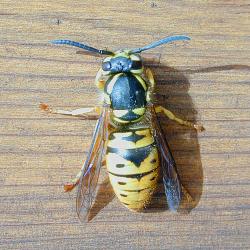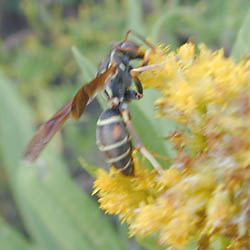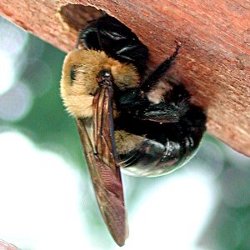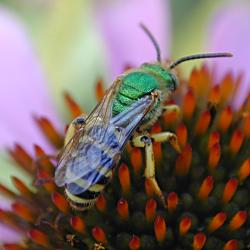|
|
| Bees and Wasps |
 European Paper Wasp
(Polistes dominulus)
Description:
Slender wasp, with smokey brown wings and two-tone antennae.
In flight, long hind legs dangle noticeably.
A recent arrival to Ontario (2001), now locally common in dry meadow, fields, backyards.
Habitat:
Dry meadow, fields, backyards.
Length: 25 mm
Adults: June - October
|
 German Yellowjacket
(Vespula germanica)
Description:
Black and yellow wasp with short, black antennae.
Wings clear.
An introduced yellowjacket, native to Europe.
Became common here in the 1960s.
Can remain active longer into the Fall than native species.
Aggressive.
These and their relatives, are the ones that cause problems at picnics.
Aggressive and nosey, they will sting readily.
Habitat:
Fields, gardens.
Length: 14 mm
Wingspan: 30 mm
Adults: June - October
|
 Paper Wasp
(Polistes sp.)
Description:
Slender brown wasp, with pale yellow stripes on abdomen.
Wings amber colour.
Long-legged - especially noticeable in flight when hind legs dangle.
Nests built of macerated wood are located in crevices and holes.
The larval cells are not enclosed in a paper skin but are
exposed to the outside.
Habitat:
Fields, meadows, gardens.
Length: 20 mm
Adults: June - October
|
 Bald-faced Hornet
(Vespula maculata)
Description:
Solid, fat-bodied wasp which is black and white.
Builds nest in trees and shrubs - nest shape varies and
can be irregular but usually has branches intertwined for support.
Habitat:
Fields, gardens.
Length: 20 mm
Adults: June - October
|
 Large Carpenter Bee
(Xylocopa virginica)
Description:
Large blue-black bee which looks like a bumblebee, but closer examination will reveal that
the thorax has a "bald patch" where there is no
hair, and the abdomen is bare (whereas bumblebees have hairy abdomens).
Slow, somewhat erratic fliers.
Overwinter as adults and emerge in spring.
Habitat:
Fields, woodland edge.
Length: 25 mm
Adults: June - October
|
 Green Metallic Bee
(Agapostemon virescens)
Description:
As the name suggests, a bright green bee with a black and white striped abdomen.
Nest underground in a branched burrow system.
Adults feed on nectar. Larvae are provisioned with nectar and pollen.
Habitat:
Fields, meadows.
Length: 12 mm
Adults: May - October
|
|
|
|
